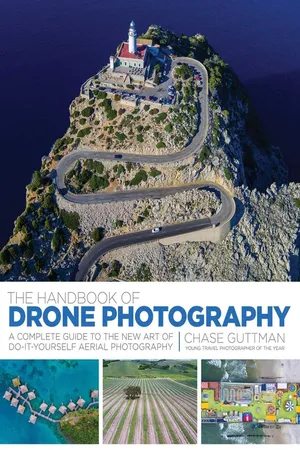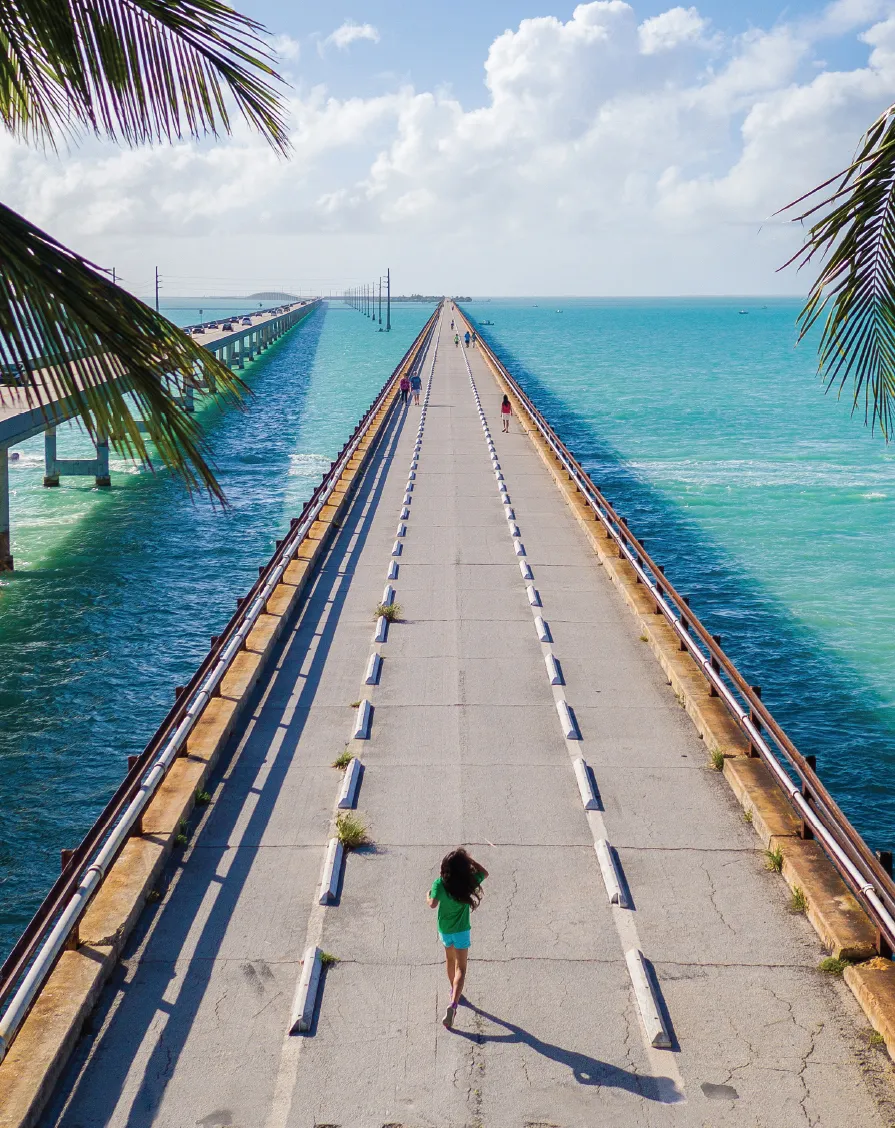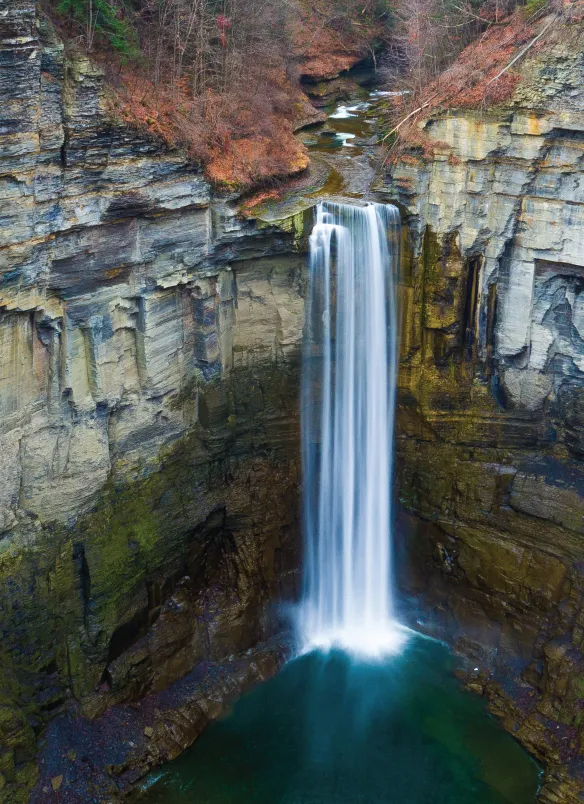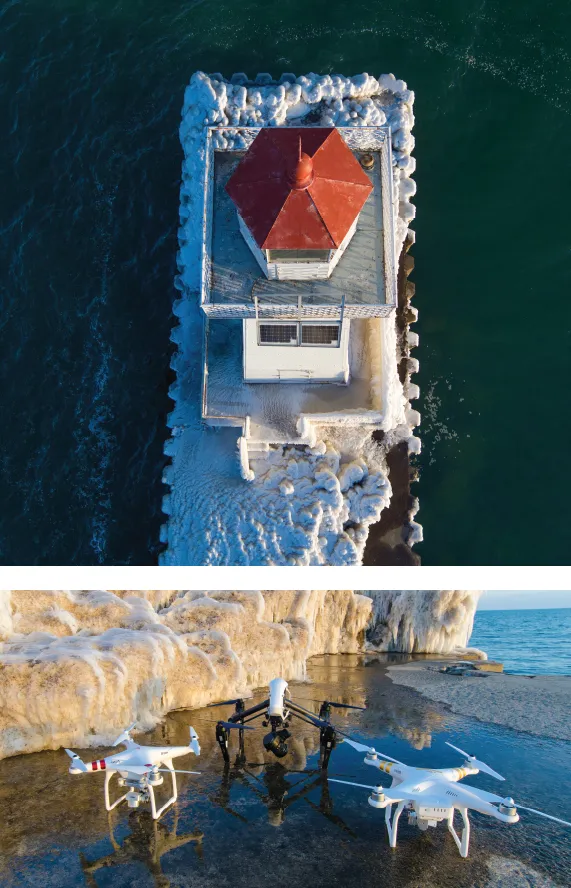![]()
| | UP, UP, AND AWAY |
![]()
| | Gallery Two: Waters |
![]()
| | Massive pieces of driftwood remain from a flooded forest on the shores of Jekyll Island, a Georgia community once home to the nation’s wealthiest families. |
| | The rocky remnants of a marble quarry abandoned in the aftermath of World War I create an aquatic playground for swimming locals near Dorset, Vermont. |
| | Maid of the Mist journeys through the thundering veil of Horseshoe Falls, a 2,600-foot long waterfall spanning two nations. |
| | An Oceania cruise ship and the azure hues of a French Polynesian coral reef are surrounded by Rangiroa, the world’s second largest atoll. |
| | The largest in a string of volcanic Polynesian islands, Hawaii is home to lush gorges and impressive 422-foot high cascades. |
| | In New York's Finger Lakes region, Taughannock’s powerful, 200-foot tall cascade is miniaturized by a wide, autumnally tinged ravine. |
| | Dwarfed by the vastness of a stormy Pacific Ocean, McWay Falls at Julia Pfeiffer Burns State Park trickles over a rocky ledge. |
| | A soft cloud of mist rises from the Niagara River's cascading torrent. |
| | Crashing Pacific waves invade the rocky crevices of the California coast near Big Sur. |
| | Circumventing the slick rock face, a hiker makes his steep descent in the shadow of a towering cataract. |
| | Limbs dangle atop an icy precipice that protrudes over a roaring cascade. |
| | As the sun disappears behind Lake Ontario, the evening's last touch of light dances around the frigid rim of Sodus Point Lighthouse. |
| | Perched high above a jagged cliff, a lighthouse seems to dangle over the Pacific Ocean. |
| | Narrow spits protect docked ships waiting to embark on turquoise-colored seas from the Keys' Faro Blanco Lighthouse. |
| | Erected at the southernmost tip of New Jersey, the Cape May Lighthouse replaced its two predecessors that were both swallowed up by the sea. |
| | In the Keys, bursts of sunlight awaken the Big Pine Key Fishing Lodge as light begins to spill into its inner harbor. |
| | A parking lot of fishing vessels stretches into the meandering marshes of New Jersey's Delaware Bay. |
![]()
FLIGHT CONTROLS
Let’s talk about how to fly. Your basic controller will have two sticks (a left lever and a right lever), with the direction that you move each stick dramatically affecting your drone’s flight path.
Starting with the left stick, a left-right motion on the left lever influences the aircraft’s yaw and an up-down motion on this lever impacts the drone’s throttle. Yaw is the direction in which your drone is facing, with a left motion rotating the UAV counterclockwise and a right motion rotating the UAV clockwise. Yaw is a critical control for amateur drone operators to understand as it’s the least intuitive of the four controls and a lack of yaw adjustment is a common cause of UAV crashes and collisions. As mentioned, yaw controls which direction your drone is facing, and for beginners it’s essential that you constantly adjust the drone’s yaw so the front of the UAV is facing away from you and the rear of the aircraft is facing towards you (known as nose out). If you fail to align the drone with yourself or, for example, you have the front of the drone facing towards you, you will be effectively flying the drone backwards and all of your controls will be inversed on the controller. The vast majority of commercial drone models have colored indicator lights that help to orient you and cue the drone operator as to which is the front side and which is the backside of the aircraft. On your first flight, you should take off with the drone properly oriented nose out, but be aware that your UAV will often drift in the course of a flight, requiring strategic yaw adjustments. As you grow more advanced, yaw can be utilized for precise maneuvers allowing you to aim the drone in a specific direction. Note that some models offer heading assist or IOC (Intelligent Orientation Control), where you can control your drone as if it was nose out, no matter the actual direction the aircraft is pointing. Throttle effectively impacts the height of your drone by dictating the overall speed of the UAV’s propellers. Again, an up-down motion on the left stick impacts the drone’s throttle. The throttle is a fairly intuitive control, moving the stick up accelerates the drone skyward and moving the stick down makes the aircraft descend.
On to the right lever—you control the UAV’s roll with a left-right movement and the drone’s pitch with an up-down motion. In short, moving this lever to the left makes the drone travel in that direction and moving the stick to the right forces the drone to the right. Similarly, an up motion results in the aircraft traveling forward and a down motion causes the UAV to venture backwards. Roll and pitch works by tilting the drone in the direction you want it to go, thus slowing down the two motors facing that direction and accelerating the motors on the opposite side. Lastly, assuming you’re in GPS mode, by releasing both of the levers on your controller and allowing them to return to their default positions, your UAV will attempt to hover still in mid-air (empowered by a mixture of GPS and ultrasonic technology as well as accelerometers and sensors).
Now that you have a basic grasp of the four main controls, it’s time to test out your skills. Learning to fly is a joy—particularly when you’re not putting a thousand-dollar piece of technology at risk. In the very beginning of your piloting career, crashes are inevitable. That is why I would strongly recommend that you purchase a trainer drone—an inexpensive toy-like drone model where you can refine your flying skills before investing in a more serious piece of hardware. Compact trainer drones, which can be purchased online for as little as $20, allow you to push yourself as a drone pilot. They’re typically durable and safe, and as these lower-end models lack all the sophisticated hardware that can be found on more expensive products, most trainer drones will be decidedly more difficult to fly. Without GPS positioning, or other auto-correcting technology, you’ll have to be a vigilant pilot, ready to react and correct to ever changing conditions and movement. As a result, if you master flight with a trainer drone, you will be able to navigate the skies with relative ease when you finally upgrade to a more feature-rich drone. In addition, you’ll be better prepared to fly your drone when you can’t obtain GPS signal. GPS technology is critical to making drones accessible to amateurs, but when you’re flying indoors or you’re surrounded by objects such as skyscrapers or mountains that obstruct your ability to latch on to a satellite signal, you may have to pilot without this assisting feature. What I did when I was first learning how to fly was give myself different navigational challenges to perfect with my trainer drone. I would challenge myself to safely maneuver my UAV in and around a series of obstacles until I became proficient in the handling of my aircraft. I would start inside, weaving my drone through hallways and whizzing over couches. Satisfied with my indoor flying abilities, I would then attempt figure eights and circles outside to further test my expertise. Inevitably my cheap drone would occasionally end up tangled in a tree, but failure is an important part of the process. In many senses, I got greater satisfaction out of accomplishing a maneuver with an inexpensive, GPS-free drone model than with an advanced UAV system that constantly makes piloting corrections for me.
Piloting skills are fairly crucial to creating phenomenal drone content. First of all, with a skilled pilot at the helm, you can greatly expand the visual range of your imagery. Battery life or time is often your greatest limitation when working in the field, and to become fluent in flying and navigation is to get the most out of your battery’s power and your time. More importantly, w...






















